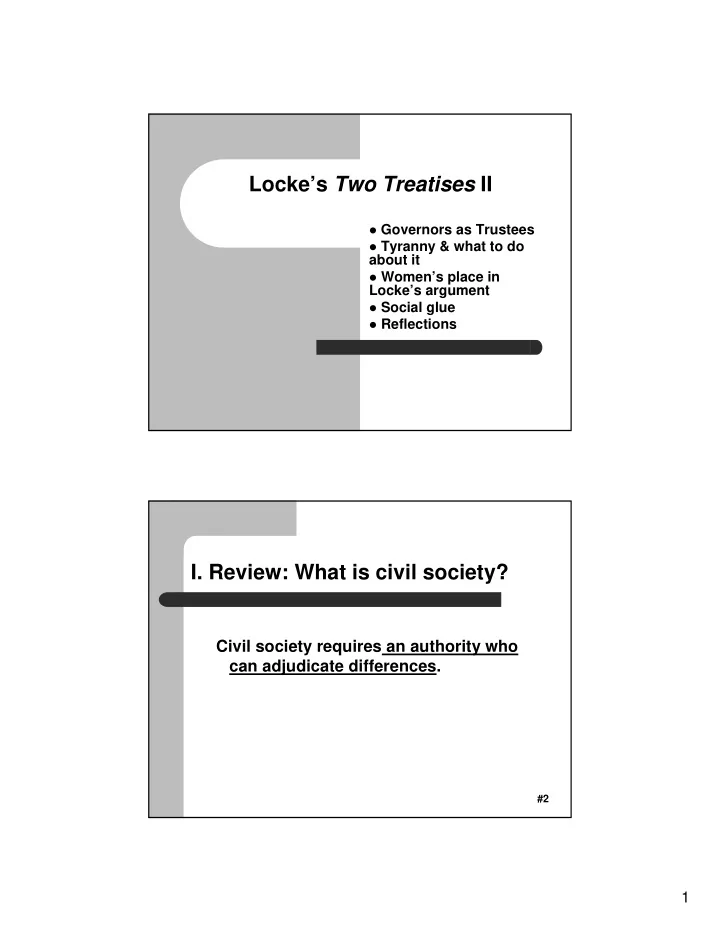

Locke’s Two Treatises II � Governors as Trustees � Tyranny & what to do about it � Women’s place in Locke’s argument � Social glue � Reflections I. Review: What is civil society? Civil society requires an authority who can adjudicate differences. #2 1
II. Governors as Trustees A. Preview: What is the social compact? “ . . . ‘tis not every Compact that puts an end to the state of Nature. . .” (§14, pp. 276-77). See also § 99, p. 333 and § 97, p. 332. B. Preview: What is consent? See IV, §22, p. 283; VIII, §119-20, pp. 347-8; see also 332 & 333. And see index, p. 453. #3 III. Governors as Trustees (cont.) A. Locke’s use of the term fiduciary: Ch. XIII, §. 149, pp. 366-7 & § 156, p.371. B. Locke’s argument for government as a form of trusteeship opposes the family /inheritance model. #4 2
IV. Tyranny & what to do about it See Bk. II, Ch. XVIII & XIX, p. 398 ff � Tyranny “ is the exercise of Power beyond Right ” (p. 398). � “ Wher-ever Law ends, Tyranny begins ” (p. 400). #5 V. Tyranny & what to do about it (cont.) A. What can be done? Can a tyrant be resisted? B. And how does Locke defend himself from the charge that his “hypothesis” in Ch. XIX “lays a ferment for frequent Rebellion” (§224 ff, pp. 414 ff.)? #6 3
VI. Women’s place in Locke’s argument: working toward a claim A. In Locke’s argument, women gain an equal or near-equal status with men. 1. Begetting and Joint dominion (Lec. I) 2. Eve’s punishment in Eden is no argument for Adam’s prerogatives (I, V, §44 ff; p. 171 ff). 3. The family is not a commonwealth (II, VII, § 86, p. 323). #7 VI. Women’s place in Locke’s argument: working toward a claim B. Given that they have joint parental power, what accounts for the inequality of husband and wife? (See Bk. II, Ch. VII, §82, p. 321) – The “Rule” has to be “placed somewhere,” so “it naturally falls to the Man’s share.” #8 4
VII. Women’s place in Locke’s argument: working toward a claim C. Do women own their own bodies? Their own labor? Do women leave the state of nature and enter civil society? Do generalizations about “all men” include women? #9 VIII. Women’s place in Locke’s argument: Claim Women’s importance is mainly rhetorical, but that rhetorical importance has implications of its own. Locke needs women (wives & mothers) to make his argument. Their centrality in the association called the family helps Locke to displace the position of the father in the state Nevertheless, women’s rhetorical importance has a substantive residue—quite beyond Locke’s purposes. #10 5
IX. Social cement Uses of social “cement” before and after Locke: 1872 BAGEHOT Physics & Pol. (1876) 184 Custom was in early days the cement of society. 1607 CHAPMAN Bussy D'Amb. (1613) Kiijb, But Friendship is the Sement of two mindes. What, in Locke’s view, is social cement? What bonds members of a society together? #11 (§. 219, pp. 410-11) X. Question - Reflection � Given Locke’s acceptance of chattel slavery and his view of women as located in the family outside civil society . . . � . . . can Locke be useful to our thinking? � Does Locke’s kind of social cement necessarily require a society to accept slavery and the exclusion of women from civil society? #12 6
Recommend
More recommend